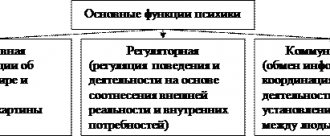Structure of consciousness
The features of consciousness include conceptuality and categoricality, self-awareness, communication with the public, and reflection of relationships. Consciousness in psychology is divided into two layers. The first is the existential, which implies the experience of actions and the most sensual images. The second is reflective, it involves understanding reality, the significance and meaning of what is happening. A similar structure of consciousness in psychology shows the complexity of solving various problems.
For example, at the existential level there is a choice to resolve the most difficult life situations; consciousness in this case helps to visualize the desired image at this moment and use the motor system, which depends on the situations of the surrounding world. At the reflexive level of consciousness, concepts, ideas, life and scientific knowledge are correlated with their meaning. If difficulties suddenly arise in understanding the meanings, then there is a misunderstanding.
The concept of consciousness. Functions and properties of consciousness.
⇐ PreviousPage 4 of 30Next ⇒CONSCIOUSNESS (conscious) is a form of reflection of objective reality in the human psyche - the highest level of mental reflection and self-regulation. The content of a person’s mental activity is determined by his consciousness, lifestyle and activities in which he is involved. Consciousness is the main attribute of human personality. It is formed and develops in the process of its ontogenesis (life course). Any study of consciousness outside of personality is impossible, since, by studying consciousness in development, psychology studies the specific process of formation of a conscious personality.
Psychology studies the origin, structure, properties and functioning of the individual’s consciousness.
Origin The leading role in the development of human consciousness was played by lifestyle. Human consciousness arose and developed in the process of social life. The prerequisites for the emergence of human consciousness were: joint productive activity of people, distribution of labor, role differentiation, development of the use of language and other sign systems, as well as the formation of material and spiritual culture.
Consciousness is recognized as the boundary separating humans from animals. What distinguishes humans from animals is, first of all, not the presence of the process of formation of mental images based on the objective perception of objects in the surrounding reality, but the specific mechanisms of its occurrence. It is the mechanisms of formation of mental images and the peculiarities of operating with them that determine the presence in a person of such a phenomenon as consciousness.
Only a person is capable of making his inner world a subject of awareness, that is, reflection. The ability to reflect determines a person’s ability to observe himself, his feelings, his state. Moreover, observe critically, i.e. a person is able to evaluate himself and his condition by placing the information received in a certain coordinate system. Such a coordinate system for a person is his values and ideals. Consequently, a person is capable of not just knowing the world, but also knowing himself, not just knowing, but knowing that you know.
The main function of consciousness is a person’s ability to relate himself to the outside world. It is this ability that allows a person to realize himself and develop as a person. To do this, consciousness uses different levels of perception and reflection of objective reality. Today there are three levels:
1. Sensory-emotional – perception and reflection of the world by the senses.
2. Rational-discursive - perception of the world through the definition of its characteristics.
3. Intuitive-volitional – promotes the integrity of perception of the world and self-awareness.
In addition to reflection and reflection of objective reality, consciousness also performs other functions, which are indicated in the following classification:
Reflective
– perception of the objective world through cognitive processes (memory, thinking, attention).
The cognitive
function, with the help of which a person reflects objective reality, builds his own system of knowledge about the world. Consciousness allows a person to penetrate into the essence of objects, processes, phenomena of the objective world, and obtain information about them. Cognition is carried out in the forms of reflection: sensory and rational - at the empirical and theoretical levels of thinking.
Estimated
- our attitude towards this world, events and ourselves, which can be expressed in the form of feelings and emotions.
The value-orientation
function, with the help of which a person evaluates the phenomena of reality, determines his attitude towards them.
Generative
– creative or creative.
Constructive and creative
function, which consists in the mental design of directions and forms of human activity in order to create something fundamentally new. Consciousness can predict, anticipate what will happen due to the operation of objective laws. This function in philosophy is often called imagination, the ability for which is one of the most powerful mechanisms of human activity.
Transformative
– management of volitional processes, where we ourselves make decisions and act.
The managerial
function with the help of which a person realizes his needs, sets goals, strives for them, that is, manages his behavior. Based on an assessment of factors and in accordance with the goals set, consciousness regulates, organizes human actions, the actions of groups, that is, it carries out a management function, ensuring reasonable regulation, self-control of human behavior and activities, and his relationships with the outside world.
Time generator
– the ability to trace the connection between the past, present and future.
The function is predictive
- a person, to a certain extent, can foresee the future with some probability, as well as predict his actions, make plans and implement them.
Reflective
– the main function that characterizes the very essence of consciousness, our ability to self-awareness.
Accumulating
– accumulation of information. The consciousness accumulates knowledge gained from personal experience, as well as knowledge obtained by previous generations of people or contemporaries. This knowledge becomes the basis for acquiring new knowledge, as well as for implementing practical actions.
Integration
– uniting all systems of perception of the objective world.
Systematizing
function, critically evaluative and descriptive, which are a consequence of those listed above.
Communicative
– determining our environment. The activity of an individual requires communication with other people, the mutual exchange of thoughts and knowledge, therefore consciousness, transforming thought into word, carries out a communicative function.
The number of such classifications continues to grow over time. This is due to new, complementary ideas of modern science of consciousness.
Having examined the main most important functions of consciousness, we found that they are all interconnected and intertwined. According to these functions in consciousness, three main spheres are distinguished, with their specific characteristics: 1) intellectual; 2) emotional; 3) motivational-volitional.
The division into these spheres is conditional, since they cannot exist without each other.
1. The intellectual sphere of consciousness includes the following properties:
— thinking: speed, systematicity, consistency, criticality, flexibility;
- memory: volume, speed of memorization and forgetting, readiness for reproduction;
— attention: volume, concentration, stability, switchability;
- perceptions: observation, selectivity, recognition ability.
2. The emotional sphere of consciousness includes the feelings themselves (joy, pleasure, grief), as well as moods and affects (anger, rage, horror, despair). To those mentioned earlier we should add such an essential component of consciousness as will, which is a person’s meaningful striving towards a certain goal and directs his behavior or action. Feelings are emotions that characterize a person’s personality. There are:
- moral feelings: humanity, love, conscience, repentance;
- aesthetic: sense of beauty, humor;
- intellectual: curiosity, surprise, doubt.
Thoughts are always connected with some feelings with a personal meaning.
3. The motivational-volitional sphere is based on human needs: biological, social and spiritual. They are the source of his activity when they are realized and embodied in specific aspirations - motives.
Properties of consciousness : universality
- any phenomena can be reflected in consciousness;
selectivity
- consciousness selects 1 element as its object;
objectivity
- reflects as it should;
goal setting
- thinking before thinking; activity; creation.
The set of properties of consciousness can be presented as follows.
I. Consciousness as a whole (properties of the system).
1. Integrity: the most important property of consciousness is its integrity. It is expressed in the unity of all its parts and functions, in their consistency.
a) connectivity - allows you to select more connected objects from a less connected environment. Connectivity is an indicator of internal connections of the whole (between its parts) and external connections between the whole and the environment;
b) limitation - limitation indicates the presence of temporal and spatial boundaries of individual consciousness. In time, it exists and functions during certain periods of each person’s life.
c) systematicity - is expressed in the presence within the whole (consciousness) of a set of elements (functions, types, forms and levels of the psyche; sensory and biodynamic tissue, meanings and meanings), connected by a certain structure (set of connections) and functioning together.
2. Ideality - A specific property of consciousness is its ideality. Its essence is abstraction, the relative independence of images and experiences from the real causes that caused them. In other words, the ideal is a special way of being of reality, when the connection between the reflected and the reflection is not direct. Consciousness can operate not with the things that actually exist, but with their “substitutes”: images, concepts, signs (with their meaning and meaning). The ideal is the relatively independent existence of the objective in subjective form.
The integrity and ideality of consciousness predetermine its reflexivity, that is, the ability to observe oneself, the ability to self-knowledge. At the conscious level of reflection, a person can perceive what is happening in his inner world, understand his mental processes and states, and influence their course and development. At the preconscious level, reflection is not available to the individual, since there is no separation of oneself from the environment yet.
3. Reflexivity - determines the property of accountability of consciousness, i.e. the representation of consciousness as a person’s ability to be aware of his actions and actions, to control them, to guide them. In a broader sense, this property is a manifestation in a person of the unity of consciousness and personality.
a) the ability to self-control;
b) accountability.
Integrity, ideality and reflexivity are properties that characterize consciousness primarily as a whole, as a system. With a certain convention, this can include such a property as continuity.
4. Continuity - the ability to reflect the past, present and future. The concept of continuity, of course, is broader, but in psychology this term is used in this meaning, so let’s leave it.
We can also point out a number of properties of consciousness that are also manifested at the level of its components, characteristic of previously studied mental phenomena structured into a single consciousness.
II. Consciousness as a system of elements (properties of elements).
5. Objectivity. — thus, the objectivity of consciousness is also manifested in the objectivity of perceptions, memory, thinking, and feelings.
6. Iconicity. — Significance (semantics) of consciousness is expressed in the symbolism of thinking and speech. The designating function is performed by emotions and psychomotor skills.
7. Constancy - Constancy (and more broadly - stability) of consciousness is linked to constancy of perception, modal indifference of short-term memory, stability of attention.
8. Centeredness - Centeredness (the ability to focus) of consciousness is directly related to concentration.
9. Activity is inherent in all levels of mental activity, and when we talk about the activity of consciousness, what is meant is not the concept of activity itself, but the highest level of its manifestation, characteristic of this level of organization of the psyche in general and for higher mental processes in particular ( for thinking, for voluntary forms of attention, memory and imagination, for volitional regulation).
10. Clarity - Clarity of consciousness is determined primarily by the flow of the attention process; This property, perhaps, is a generalization of the properties of attention (concentration, stability, switchability, distribution, etc.). The concept of “clarity” also applies to the intellectual sphere: clarity of thought and speech. The expression “blessed memory” is close in meaning. Views vary in degree of clarity. The main thing in this characteristic is, of course, the degree of awareness of the object, but clearly woven into it are also clear boundaries, balance, and brightness of the image. Consequently, this property is not purely a quality of consciousness.
11. Sociality - Often, such a characteristic as sociality is cited as a property of consciousness. But, apparently, the social aspect of the human psyche should be considered not so much as a property of this or that mental phenomenon, but as a condition for its emergence, formation, development, and existence in general. Socialization is a mechanism for transferring mental reflection to a conscious level. At the same time, socialization is impossible without a sufficient level of mental organization. These are inseparable, mutually determining aspects of human development. This formation occurs simultaneously both as an increase in the level of organization of the psyche, and as the formation of personality in the process of human activity, primarily joint labor activity. Therefore, it is better to talk not about the sociality of consciousness as its property, but about consciousness as a quality of mental activity determined by social factors.
Thus, the above allows us to give the following general characteristics: consciousness is the highest, characteristic only to man, function of the brain associated with speech, consisting in a generalized and purposeful reflection of reality, in the preliminary mental construction of actions and anticipation of their results, in the reasonable regulation and self-control of human behavior .
⇐ Previous4Next ⇒
Properties
Consciousness has several fundamental properties: categoricalness - it reflects the world around us with the help of knowledge and social position, awareness of its activities, a conceptual model of personality and the construction of contacts with reality. In addition, human consciousness helps to analyze the relationships of specific situations.
Functions of consciousness
Acting as the most important component of personality, consciousness successfully performs a number of functions, including the following:
- cognitive – thanks to consciousness, a person forms a system of knowledge;
- goal-setting - the individual is aware of his needs, carries out goal setting, planning strategies to achieve his goals;
- value-oriented – a person analyzes, evaluates phenomena and processes of reality, and formulates his attitude towards them;
- managerial - the individual exercises control over his own behavior, the implementation of his own behavioral patterns in accordance with the set goals, formulated strategies for achieving them;
- communicative – consciousness exists and is transmitted in a symbolic form, and is closely related to the communicative activity of the individual;
- reflexive – thanks to consciousness, a person exercises self-control, self-awareness, self-regulation, which provides opportunities for personal development.
Finished works on a similar topic
- Course work Structure of consciousness 440 rub.
- Abstract Structure of Consciousness 260 rub.
- Test work Structure of consciousness 200 rub.
Receive completed work or specialist advice on your educational project Find out the cost
Self-awareness
This concept is interpreted differently in psychology. There are also different approaches to this issue. For example, the scientist V. Bekhterev says that self-awareness precedes consciousness, but S. Rubinstein claims that it is only a stage in the development of consciousness. Doctor I. Sechenov said that self-awareness develops simultaneously with consciousness.
A person’s self-awareness does not arise immediately, as it develops gradually; it is influenced by many social factors that arise throughout life. Self-awareness includes four components: awareness of one's self, the ability to distinguish one's personality from others, the manifestation of self-esteem and the ability to notice one's mental properties.
Stages and functions of self-awareness
Self-awareness is an individual’s perception of himself, understanding of his differences from others, awareness of his needs, emotions, feelings, experiences.
Self-awareness performs the following functions:
- Distinguishing yourself from others, accepting your individuality.
- Maintaining consistency of actions and behavior, responsibility for one’s actions.
- Motivation for a specific activity.
- Formation of a model of relationships with others.
- The ability to develop personality traits, control emotions and feelings.
In its development, self-awareness goes through the following stages :
- Natural . The child learns to distinguish and perceive sensations and the effects of external factors on him with the help of sensorimotor intelligence.
- Social .
A person perceives himself, evaluates and compares with others. At this stage, self-respect and will appear. - Personal . The individual understands the reasons for his actions and evaluates the possibilities for further development.
Thus, the psychological structure of self-awareness consists of the following components :
- self-knowledge;
- self-control and self-regulation;
- self-esteem;
- self-acceptance;
- self-respect.
Stages of development:
- Awareness of identity, differentiation of oneself. Develops by 12 months of the baby’s life.
- Understanding oneself as a subject of society and activity. Appears at 2-3 years of age.
- Acceptance of individual mental characteristics. Formed in teenagers.
- Formation of moral and ethical principles. Begins to develop in adolescence.








